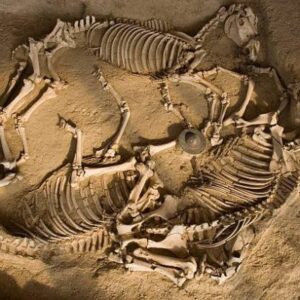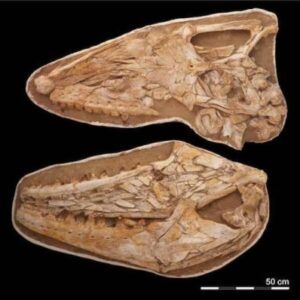The mummy of Queen Nodjmet was discovered in the Deir el-Bahari Royal Cache (DB320). Artificial eyes, crafted from white and black stones, adorned the mummy. Real hair formed her eyebrows, and she wore a wig. The body and parts of her face were colored to impart a more lifelike appearance.
Nodjmet was an ancient Egyptian noblewoman from the late 20th Dynasty or early 21st Dynasty, the wife of Herihor, the High Priest of Amun at Thebes. She may have been a daughter of Ramesses XI. In her early life, she held titles such as Lady of the House and Chief of the Harem of Amun.
King Herihor and Queen Nodjmet’s devotion to Osiris is depicted in detail in the Book of the Dead of Nodjmet.
Two Books of the Dead were found with her mummy. One, Papyrus (EA10490), now housed in the British Museum, belonged to “the king’s Mother Nodjmet, the daughter of the king’s Mother Hrere.” Another Book of the Dead from her tomb is also in the British Museum’s collection (EA10541) and is one of the most beautifully illustrated papyri from ancient Egypt.
Nodjmet had several children: Heqa-nefer, Heqa-maat, Ankh-ef-en-mut, Fai-en-mut, and the future High Priest of Amun/King Pinudjem I.
Rarely displayed, the version of this funeral text that accompanied Queen Nodjmet into the afterlife—a richly illustrated piece of papyrus over four meters long and 3,000 years old—will be featured in the British Museum exhibition.
The queen’s body was filled with sawdust, and her hands were set by her sides. Between the layers of her wrappings, a heart scarab and four small figurines of the Four Sons of Horus were found. The embalming wound, as well as her eyes, nose, mouth, and ears, were covered by wax.
The mummy of Queen Nodjmet holds significant historical and archaeological importance.
**Royal Lineage**
Queen Nodjmet was a member of the prestigious 21st Dynasty, which played a crucial role in the political landscape of ancient Egypt. Her mummy provides valuable insights into the lineage and connections of this dynasty.
**Historical Context**
The Third Intermediate Period was a time of political fragmentation and instability in Egypt. Queen Nodjmet’s mummy helps historians and archaeologists understand the individuals and families involved in the power struggles of this era.
**Artistic Representations**
The mummy of Queen Nodjmet is adorned with intricate funerary jewelry and wrappings, showcasing the artistic and cultural practices of the time. These details contribute to our understanding of ancient Egyptian burial customs and the craftsmanship of the period.
**Scientific Analysis**
Modern scientific techniques, such as CT scans and DNA analysis, have been applied to Queen Nodjmet’s mummy. These studies provide valuable information about her health, cause of death, and familial relationships, shedding light on the medical and genetic aspects of ancient Egyptian society.
**Mummy of Queen Nodjmet**
The 21st Dynasty marks a significant shift in the art of mummification in ancient Egypt, particularly in the preservation techniques applied to the elite class. This era witnessed a newfound interest in maintaining the discrete self-sufficiency of the preserved body.
As the Bronze Age drew to a close, notable changes emerged in the embalmer’s art. A notable departure from previous practices was the norm of returning internal organs to the body after preservation, rather than entombing them in separate canopic jars and chests. Unlike earlier dynasties, the mummies of the 21st Dynasty were not fragmented into different containers. Instead, when the embalmed organs were reintegrated into the mummy, the corpse remained intact and whole, embodying a self-contained entity.
Several other innovations surfaced during this period. The natural and full appearance of the body was now meticulously restored. In the case of Queen Nodjmet, packing was placed under her cheeks to restore facial fullness, along with external padding on the body to revive the lifelike quality of the torso and limbs. This marked a departure from the lax and drawn skin of mummies from the New Kingdom, allowing desiccated flesh to sink into the bones.
A desire for a more lifelike facial presentation emerged during the 21st Dynasty. Embalmers of this period painstakingly repaired any defects in the body and skin, using leather patches and plaster to mend tears. They even addressed anatomical issues by adding additional limbs made of wood. The mummy’s skin was finished with a coating of plaster, adorned with red or yellow paint, depending on the deceased’s gender.
The insights into these advancements are eloquently presented in “Objectifying the Body: The Increased Value of the Ancient Egyptian Mummy during the Socioeconomic Crisis of Dynasty Twenty-One” by Kathlyn Cooney.
**Mummy of Queen Nodjmet: Innovative Mummification Techniques**
Nodjmet’s mummy, discovered at the Deir el-Bahari Cache (TT320) in the 19th century, stands out as a testament to innovative mummification practices. This ancient Egyptian woman, likely elderly at the time of her death, underwent a unique embalming process involving the use of artificial eyes and limb packing.
The artificial eyes, crafted from black and white stones, aimed to impart a lifelike appearance to the mummy. Limbs and face were also carefully colored to simulate a sense of vitality. Despite her age, Queen Nodjmet was adorned with a wig and false eyebrows made from human hair to project a youthful image.
Unfortunately, Nodjmet’s body suffered disturbance in modern times, evidenced by gashes on her forehead, nose, and cheeks, likely inflicted by thieves searching for valuables. The impression of jewelry on her right arm suggests that some precious items were pilfered.
Queen Nodjmet’s mummy holds significance for its contributions to history, culture, art, and science. It serves as a crucial puzzle piece in understanding ancient Egyptian history and offers a glimpse into the lives of royalty during the Third Intermediate Period.
Dating back to the Third Intermediate Period, 21st Dynasty, circa 1069-945 BC, the mummy is now housed in the Egyptian Museum in Cairo under the inventory number JE 26215.





